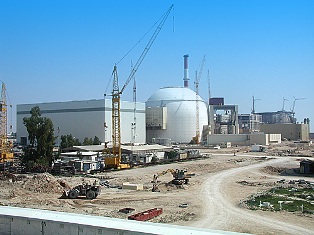The eighth and final shipment of nuclear fuel from Russia to the Bushehr nuclear power plant in Iran has been completed. Russia said it is now working to complete the plant as soon as possible.

The Islamic Republic News Agency (IRNA) said that the last shipment of fuel arrived in Iran on 28 January. The shipment of five tonnes of fuel followed closely on from the seventh such shipment, which consisted of 11 tonnes of fuel and arrived in Iran on 26 January. The Atomic Energy Organization of Iran (AEOI) has now received a total of 82 tonnes of fuel for the initial fuel loading of the Bushehr plant, together with auxiliary equipment from Russia.
The first shipment of fuel for the plant arrived in Iran from Russia on 16 December 2007 following months of delays that Russia attributed to payment arrears by Iran, but which Iran blamed on pressure from Western countries. Iran has been accused of seeking to develop nuclear weapons under the cover of a civilian nuclear program. Iran's determination to develop a domestic uranium enrichment facility has led to the imposition of sanctions by the UN Security Council and serious international tension.
Under a Russian-Iranian agreement on Bushehr, nuclear fuel deliveries to the plant were to start about six months prior to commissioning of the plant. Russia has now supplied a total of 163 basic and 17 reserve fuel assemblies to Iran for the initial fuel load for the Bushehr 1 reactor. AtomStroyExport (ASE), the Russian company contracted to complete the plant, said in December that the full delivery will take up to two months.
On 13 December, ASE reported that Moscow and Tehran had reached agreement on a schedule for completing construction of Bushehr. Iran had provided additional written guarantees that the fuel, containing uranium enriched to 3.6% uranium-235, would only be used for generating electricity at Bushehr. Under the agreement, used fuel from Bushehr would be returned to Russia for reprocessing and storage.
ASE said that the fuel deliveries were monitored by the International Atomic Energy Agency (IAEA). The fuel will now be stored at an on-site fuel storage facility, which has already been placed under the IAEA safeguards regime and international security and monitoring system.
Sergei Shmatko, president of ASE, earlier told the Itar-Tass news agency that Russia intends to complete the Bushehr plant as soon as possible. He said, "We have settled with the customer all questions and problems that existed." Shmatko added, "The time of completing the Bushehr project is of principal nature for the customer. We shall work to complete all things at the earliest."
Preparation for the loading of the fuel into the reactor will start in July or August, Sergei Kiriyenko, head of the Federal Atomic Energy Agency (Rosatom) told Itar-Tass. He noted that there is "an agreed schedule" for the start of Bushehr's operation. Kiriyenko also said that "there are no unresolved problems in mutual relations. Therefore, contractors are working with a swing." He said that "Russia's stand is 'the quicker the better', since the station has a high degree of readiness. The quicker it is put into operation, the better."
Bushehr 1 will be a unique VVER-1000 pressurised water reactor (PWR), built by ASE from pre-existing site works made by Siemens. Bushehr 1 was originally intended to be a Kraftwerk Union PWR to supply about 1200 MWe to the grid from 1981. Work was 85% complete when the project was halted after Iran's Islamic Revolution of 1979. In 2002, ASE signed a deal to complete the unit to its own design.
Meanwhile, Javad Vaeedi, deputy head of Iran's Supreme National Security Council, told a congregation of the Islamic Revolutionary Guards Corp on 27 January that Iran has so far produced 300 tonnes of uranium hexafluoride (UF6). According to the local Fars news agency, he said: "The Isfahan uranium conversion facility is active and it has produced more than 300 tonnes of UF6."






_53514_33880.jpg)






